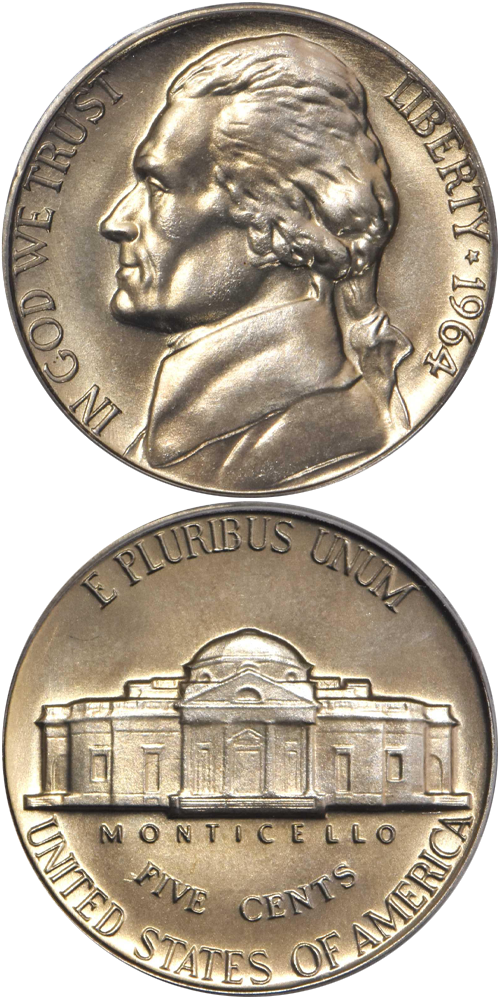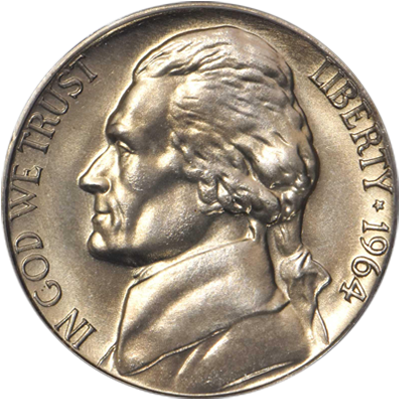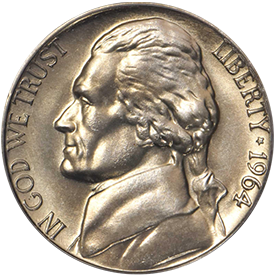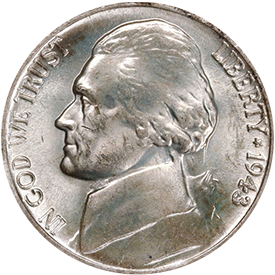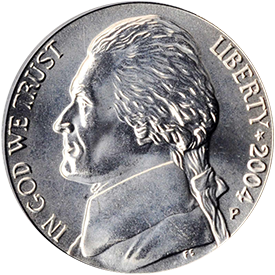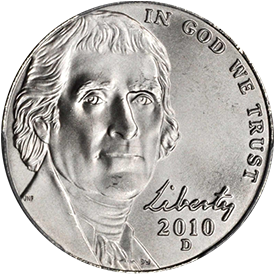The Jefferson Nickel, a design by an independent artist, Felix O. Schlag who won a competition against 390 others, made its debut in 1938. It featured a profile of Thomas Jefferson facing left, and a front view of his home, Monticello, in Charlottesville, Virginia, on the reverse. It continued the trend towards using actual people on our coinage rather than the symbolic “Miss Liberty.” By 1938, the Lincoln Cent and Washington Quarter were circulating, and the following decade, a dime portraying Franklin Roosevelt and a half portraying Benjamin Franklin would complete the transition away from nameless representations of “Liberty.”
Shortly after its introduction, World War II broke out, and from 1942 through 1945, silver was substituted for nickel in the alloy. This may sound strange today as silver is a precious metal, but at the time, nickel was more useful in the war effort than silver. These “war nickels” can all be identified by a very large mintmark above Monticello on the reverse – with Philadelphia even using the “P” mintmark for the first time.
In 1946, the regular copper-nickel alloy returned, and the nickel remained unchanged until 1966, when the tiny initials “FS” were added below Jefferson’s bust on the obverse. In 2004-2005, a special series of nickels was issued celebrating both the bicentennial of the Louisiana Purchase and the journey of Lewis and Clark. Dubbed the “Westward Journey” series, it featured new reverses in 2004, and a new profile obverse in 2005, along with additional new reverses.
In 2006, a new facing portrait of Jefferson designed by Jamie Franki and sculpted by Donna Weaver replaced Schlag’s profile design, but the original reverse picturing the facing view of Monticello returned. Schlag’s initials were also moved to the reverse, just to the right of Monticello. “Liberty” on the obverse is shown in cursive script, somewhat unusual on U.S. coinage.
Collectors of Jefferson nickels today often focus on the steps visible on Monticello on the reverse. Weakly struck coins often show only a few steps or in some cases, none at all! A “full step” nickel is now a premium coin, much as the “full head” Standing Liberty Quarter or the “full band” Mercury dime.
Full Steps
The steps on Jefferson’s home of Monticello on the reverse are often not fully struck, and if the five steps beneath the columns are all visible and distinctly separated, then the designation “FS” or Full Steps is given. Note that if a mark or small scratch interrupts the lines, then the coin will fail to qualify. (See the second photo from left.)

Further Reading
Jefferson nickels, still being minted today, were first coined in 1938. The design represents the work of Felix O. Schlag, an independent artist who entered a national competition with approximately 390 others and who won a monetary award of $1,000 plus the intangible benefit of seeing his design produced on billions of coins. The obverse portrays a handsome bust of President Jefferson. The reverse depicts Jefferson's home, Monticello, located in Charlottesville, Virginia. The original Schlag design showed a view of the building from a corner, but the finished result is a plan view or head-on depiction. The dome of Monticello is bare – that is, it does not have a flagpole. When these nickels were first released it was reported that the Mint had made an error and that nickels without flagpoles would become valuable. Billions of coins later, Monticello still has no flagpole!
Specimens were coined from the outset at Philadelphia, Denver, and San Francisco. In 1942, due to wartime demands for nickel metal, a special alloy of copper, silver, and manganese was produced for five cent piece coinage. It was realized at the time that in some future date it would be necessary to separate these special-alloy coins from others when worn pieces were turned into the Treasury for reclamation. This separation was necessary in order to more easily melt down the pieces and separate the various metals. To aid in this future recovery, mintmarks, including a large P for Philadelphia (representing the first time that such an initial was ever used to represent that mint), were placed above Monticello on the reverse.
These pieces, which were nicknamed "wartime nickels" (by Harry Forman, I believe), were made from 1942 through 1945. Uncirculated examples have a particularly brilliant, lustrous, and frosty appearance due to the silver content. However, worn examples are duller than those made from nickel alloy. Sometimes the wartime issues are collected separately as sets.
An interesting variety of 1944 nickels made the news a number of years ago. Some enterprising counterfeiters decided to make coins of this date. Unfortunately, they didn't have a copy of A Guide Book of United States Coins, nor did they know anything about coins. To create the obverse die they copied a 1944 nickel. For the reverse die they copied a Philadelphia Mint nickel of some other date, but not one of the wartime issues. In any event, unlike real 1944 nickels produced by the Philadelphia Mint, which bore a large "P" mintmark over the dome of Monticello, the counterfeits had no mintmark at all. When first released in circulation these were sighted by numismatists and deemed peculiar, an event which led to the capture and arrest of the counterfeiters!
In 1946 the coinage of regular nickels of the usual alloy (75% copper and 25% nickel) was resumed. In 1966 a minor change was made by adding the letters FS, the first and last initials of Felix O. Schlag, on the obverse of the coin. Agitation by Coin World and by columnist Mort Reed was largely responsible for this long-overdue recognition of Schlag's 1938 accomplishment. The artist, however, stated that he would have preferred use of his full initials, FOS.
In 1968 another change occurred. The mintmark position was moved from the back of the coin to the front. All branch mint issues since 1968 feature a letter below the date.
A number of interesting varieties occur in the Jefferson nickel series. Certain 1939 pieces exist with the words MONTICELLO and FIVE CENTS sharply doubled; a phenomenon similar to that on the 1955 Doubled Die cent. This was caused by a shift in the hub die in the preparation of the coining die. Specimens of this variety are fairly scarce, but as they have not been publicized, they are not particularly expensive. Uncirculated examples are rarities.
Overmintmarks exist for 1949-D/S, 1954-S/D, and 1955-D/S. These are fairly scarce, but as popular albums do not have openings for them, they are not in great demand (and, thus, are relatively inexpensive). While some specialists delve into overmintmarks or seek the 1943/2-P (which was discovered in recent years), most collectors endeavor to own one each of the standard date and mintmark issues. Several are scarce. As might be expected, issues of 1938, the first year, were saved in somewhat larger numbers due to the novelty of the design and, to a lesser extent, to the rumor of the flagpole error. Among early issues 1939-D is the scarcest and has always been considered the key date. 1939-S is elusive in Mint State. The 1942-D nickel struck in regular (not wartime) alloy is likewise scarce in Uncirculated grade.
The most famous of all Jefferson nickel "rarities" is the 1950-D. When Mint reports indicated that just 2,630,030 nickels were made of that issue, a figure far lower than for any other in the series, a wild scramble commenced. A number of dealers and collectors, notably A.J. Mitula of Texas, succeeded in acquiring large quantities before they were released into circulation. The price of $2 for a roll of 40 coins quickly jumped to $6, then to $10, then to far more. At one time (around 1964) rolls sold for as much as $1,200! Later the fever subsided. A.J. Mitula maintained a summer place in Cascade, Colorado, on the slopes of Pikes Peak. He was fond of calling it "the house that 1950-D nickels built." The 1950-D nickel indeed proved to be rare in circulation. Today worn pieces are seen less often than are Uncirculated coins.
Collecting Jefferson nickels by dates and mintmarks has been a popular pursuit for many. Interestingly, the price of a complete set moved relatively little from the early 1960s through the next two decades. Coin prices tend to follow cycles, and when values are doubling, tripling, or quadrupling in some other series, prices in another area may trend upward only slightly. Then the order of things changes, and a previously "hot" area cools off, and a dormant series has its day in the sun.
Some numismatists have made a specialty of Jefferson nickels. Those interested in going into the field more than just casually may want to investigate obtaining a strong magnifying glass with the object of seeking as many sharply struck pieces as possible. The steps on Monticello on the reverse have usually been designated as the benchmark for deter mining striking sharpness. Coins designated as "full steps" have all of the parallel step lines sharply visible, and in recent years, Jefferson nickels with “full steps” have become the object of desire for many collectors of the series.
The wartime series of nickels from 1942 through 1945 (the issues struck in silver alloy with mintmarks above the dome) are for the most part readily available with full steps. The wartime alloy was softer and easier to strike than the normal nickel alloy, so metal flowed more readily, and the deepest recesses in the die were filled completely. Further, with this alloy the dies were less subject to wear and remained sharp for a longer period of time. 1944-S and 1945-S are scarce with full steps, however.
Considering the rest of the series, issues struck in regular nickel alloy, many variations can be found. 1939 (Philadelphia) nickels are common in Uncirculated grade, but with full steps they are relatively elusive. Other early issues which are scarce to relatively rare with full steps include 1939-S, 1940-S, 1941-S, and most other San Francisco coins through 1954.
In the Jefferson nickel series, it seems that the later the date, the sloppier the strike. Perhaps this was caused by the diminished purchasing power of the nickel, the vastly increased quantities of production, and emphasis on government economy (keeping worn dies in use for a longer period of time). 1952 Philadelphia issues, even those taken from original rolls, are apt to have dark purplish or brown surfaces with many marks. As if this were not enough, the strikes are likewise usually poor. Philadelphia Mint nickels of 1953, 1954, and 1955 often display wear characteristics as do those of 1957 and 1958. 1962-D is rare with full sharp striking and minimal bagmarks.
Bernard Nagengast, a student of the series, observed in 1982 that sharply-struck 1962-D nickels commanded prices as high as $175 (at a time when a normal Uncirculated coin was worth a half dollar or less!). In sharply struck condition the 1963-D, 1964-D, 1968-D, 1969-D, and 1970-D are likewise elusive for the specialist. In a letter dated January 1, 1984, Nagengast, whose publication The Jefferson Nickel Analyst has achieved wide recognition, wrote to me as follows:
"As for 'full step' rarity, the ten rarest issues in M5-63 or better condition, fully struck with five or more steps, by actual appearance observed in the market are: 1953-S, 1969-D, 1960-D, 1961-D and the following: 1954-5, 1962-D, 1963-D, 1964-D, 1968-D, and 1970-D."
Today, the rarity of full-step Jefferson nickels is dictated by the population reports published by PCGS and NGC. While nearly all dates and mints are known with full-steps, dates such as the 1960-D, 1961-D, 1969-D, 1969-S are either unknown or prohibitively rare, with prices well into mid-five-figures when they do turn up.
In recent years, the Westward Journey series of 2004-2005 featured new reverse designs in 2004, and a new ¾ profile obverse design in 2005 along with additional new reverse designs. In 2006, the original Monticello reverse returned but the obverse featured a new facing portrait of Jefferson designed by Jamie Franki and sculpted by Donna Weaver.
As a series, Jefferson nickels have much to offer. As noted, they can be collected casually by date and mintmark or technically by overmintmarks and full steps to Monticello. Either way, the series comprises dozens of different issues with a relatively low total cost.
